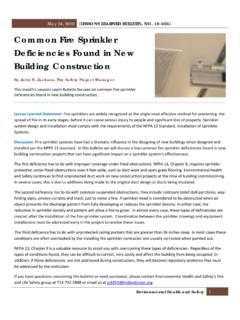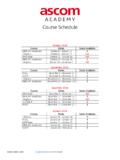Transcription of Nurse Call / Communication Systems
1 Element D Services Electrical D5034 Nurse call / Communication Systems The University of Texas Nurse call / Communication Systems MD Anderson Cancer Center D5034 ODG092216 1 OF 15 PART 1 - GENERAL OVERVIEW A. This Section includes design criteria for developing technical specifications on Nurse call / Communication Systems . B. The general purpose of this Design Guideline Element is to provide minimum criteria for Nurse call / Communication Systems design at MD Anderson facilities regarding application for in-patient, diagnostic imaging, outpatient clinics, and surgery areas that are code compliant and uniform. PART 2 - GENERAL DESIGN CRITERIA GENERAL A. To protect the health and safety of patients, visitors, students, faculty and staff, all installation must be in accordance with: 1. NFPA 99, Standard for Health Care Facilities 2015 Edition 2. Hospital Licensing State Regulations and Facility Guidelines Institute (FGI) 2014 Edition - Guidelines for Design and Construction of Health Care Facilities 3.
2 Texas Administrative Code Chapter 133, Hospital Licensing 4. UL 1069 Hospital Signaling and Nurse call Equipment compliant and Electronics Institute of America (EIA) Standards. B. Power for the Nurse call / Communication Systems shall be provided from the critical branch of the electrical emergency system , which is connected to alternate power sources by one or more automatic transfer switches during interruption of normal power. C. There shall be no interconnection between the Nurse call / Communication Systems and the fire alarm system . D. There shall be no interconnection between the Nurse call / Communication Systems and an intercom system . E. Public toilet rooms (those that are labeled as such or those not labeled as patient toilet rooms) shall not have bathroom pull station. There are some exceptions, which must be determined in writing by the operating department and Clinical Engineering, in advance. F. All LAN cable runs shall comply with Master Construction Specification Sections 27 13 00 and 27 15 00 for communications cabling.
3 Element D Services Electrical D5034 Nurse call / Communication Systems The University of Texas Nurse call / Communication Systems MD Anderson Cancer Center D5034 ODG092216 2 OF 15 G. For outpatient Clinics the following factors determined if a Nurse call system is required: 1. Condition #1, If the patient is under general anesthesia, conscious sedation or other factors that affect the patient s ability to care for their wellbeing and be in control of their mobility as a need may occur then Nurse call is required. 2. Condition #2, Code does not require general care outpatient Clinics to have Nurse call / communications Systems . 3. Condition #3, however each operational unit must evaluate their procedures and effect on their patient s safety, this is the final determination of needing a Nurse call system . CAUTION: each operational unit must be consistent in having a Nurse call system or not at all, there may not be a mix within their operational area.
4 PART 3 - DESIGN CRITERIA FOR OUTPATIENT AND SURGERY AREAS GENERAL A. Effectiveness of Alarms: 1. In areas where the nursing staff is unable to see the zone light or hear the audible alarm, consideration must be made to add audible annunciators at each of the zone lights. This consideration must be reviewed with the Manager / Director that is responsible for the department. Nurse REGULAR call system (PATIENT STATION) A. A Nurse regular call system is intended for routine Communication between each patient and the nursing staff. Activation of the system at a patient's station will sound a repeating (every 20 seconds) audible signal at the Nurse station, indicate type and location of call on the system monitor, and activate a distinct visual signal in the dome light outside the patient room door. B. In multi-corridor nursing units, additional zone lights shall be installed at corridor intersections to act as a guide to the alarm location.
5 Zone lights are also used to facilitate / guide Code Blue and Merit teams from floor and unit entrance points to the originating alarm location. C. The audible signal shall be canceled and two-way voice Communication between the patient room and the nursing staff shall be established at the unit's nursing station when the nursing staff answers the call . The visual signal(s) in the corridor shall be canceled upon termination of the call . An alarm shall activate at the nurses station when the call cable or pillow speaker is unplugged, where installed. D. Nurse regular call stations will be provided at: 1. All patient bed locations. 2. Some examination / treatment rooms, as required by the Project Facility program or Pre-Design Report. Element D Services Electrical D5034 Nurse call / Communication Systems The University of Texas Nurse call / Communication Systems MD Anderson Cancer Center D5034 ODG092216 3 OF 15 E. Nurse call Cancelation buttons will be placed at the entrance of each patient room in Alkek and Lutheran In-Patient rooms, in addition to the Cancellation button on the patient station on the headwall.
6 Nurse EMERGENCY call system (PULL / BATH / LAVATORY STATION) A. A Nurse emergency call system is intended for patients to summon nursing staff in an emergency. Activation of the system shall sound a repeating (every 5 seconds) audible signal at the Nurse station, indicate type and location of call on the system monitor, and activate a distinct visual signal in the dome light outside the patient room door. B. In multi-corridor nursing units, additional zone lights shall be installed at corridor intersections to act as a guide to the alarm location. Zone lights are also used to facilitate / guide Code Blue and Merit teams from floor and unit entrance points to the originating alarm location. C. Activation of the system shall also activate distinct visual signals (Duty Station) in the clean workroom, in the soiled workroom, medication, charting, clean linen storage, nourishment, and equipment storage except outpatient areas. D. A Nurse emergency call system shall include an anti-microbial pull cord extending to within six inches of the floor accessible to a collapsed patient lying on the floor.
7 E. Nurse emergency call stations will be provided at: 1. All lavatories designated for patients (excluding public waiting areas, unless Nursing identifies a specific patient risk). 2. All showers designated for patients (must be within reach of a 5 foot tall person to cancel the call ). STAFF EMERGENCY ASSISTANCE call system (CODE BLUE STATION) A. A staff emergency assistance call system (code blue) is intended to be used by staff to summon additional help in an emergency. In open suites, an emergency assistant call system device shall be located at the head of each bed and in each individual room. B. Activation of the system will sound an audible signal at the nursing unit's Nurse s station, indicate type and location of call on the system monitor and activate a distinct visual signal in the dome light outside the patient room door. C. In multi-corridor nursing units, additional zone lights shall be installed at corridor intersections to act as a guide to the alarm location.
8 Zone lights are also used to facilitate / guide Code Blue and Merit teams from floor and unit entrance points to the originating alarm location D. Activation of the system shall also activate visual and audible signals in the clean workroom, in the soiled workroom, medication, charting, clean linen storage, nourishment, equipment storage, and examination/treatment room(s) with back up to a continuously staffed area (other than the Nurse station or an administrative center) from which assistance can be summoned E. In critical care units, recovery and preoperative areas, the call system shall include provisions for an emergency code resuscitation alarm to summon assistance from outside the unit. Element D Services Electrical D5034 Nurse call / Communication Systems The University of Texas Nurse call / Communication Systems MD Anderson Cancer Center D5034 ODG092216 4 OF 15 F. The system shall have voice Communication capabilities so that the type of emergency or help required may be specified.
9 G. Staff emergency assistance call stations will be provided at: 1. All patient bed locations. 2. Each recovery, emergency examination and/or treatment area, critical care unit, special procedure room, cardiac catheterization room, angiography room, stress-test area, triage, and outpatient surgery, admission and discharge area. 3. Each imaging suite procedure room. 4. Each nuclear medicine suite treatment, diagnostic, observation, and secondary recovery room. 5. Each outpatient suite treatment, diagnostic, observation, and secondary recovery room. COMMISSIONING / ACCEPTANCE TESTING A. Testing will be conducted by Clinical Engineering prior to the first patient use. B. The Commissioning sheet is available from Clinical Engineering upon request, which shows more specific details which are not provided within this document. PART 4 - SPECIAL CONTRACT DOCUMENT REQUIREMENTS system APPLICATION A. If there are no specific requirements regarding Nurse call / Communication Systems defined within the Project Facility Program or Pre-Design Report, the A/E shall request a list of examination, treatment, or other rooms to be provided with Nurse call / Communication Systems .
10 This request shall be submitted in writing through the Owner s Project Manager to MD Anderson Patient Care Facilities and Prevention Facilities - Clinical Engineering. B. Refer to Attachments A through H at the end of this Design Guideline Element for application of Nurse call / Communication Systems devices and components required for various room types within MD Anderson facilities and tables of system components required by each product manufacturer. PART 5 - PRODUCTS MANUFACTURERS A. Approved Nurse call / Communication Systems for MD Anderson are as follows: 1. In-Patient care areas and Diagnostic Imaging (G3) in Alkek / Lutheran Main Campus buildings: Element D Services Electrical D5034 Nurse call / Communication Systems The University of Texas Nurse call / Communication Systems MD Anderson Cancer Center D5034 ODG092216 5 OF 15 a. Ascom (formally known as General Electric) C600 Standard daisy chain configuration head end (server located on ), compatible with existing Ascom (formally known as General Electric Telligence Systems ).




